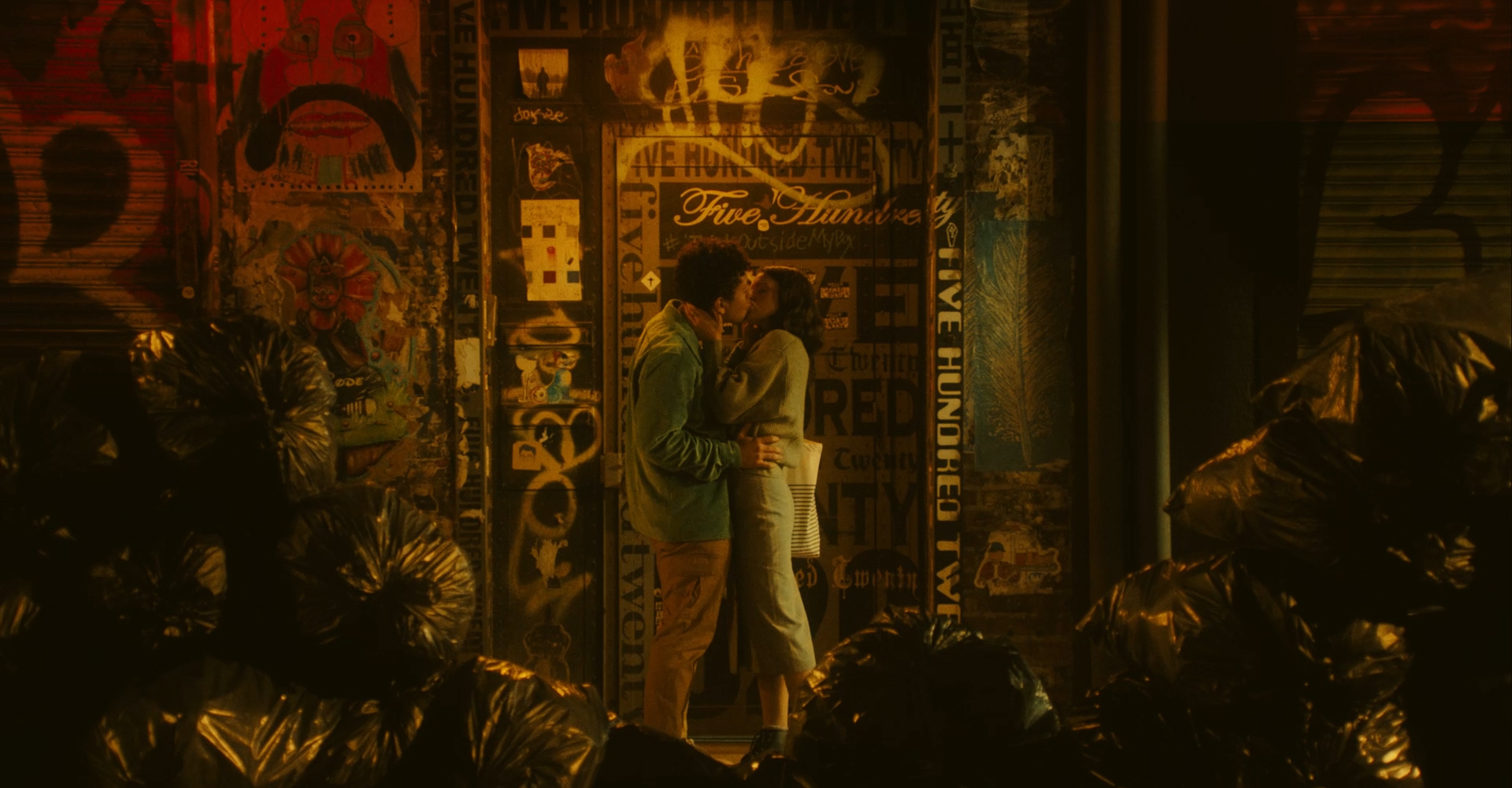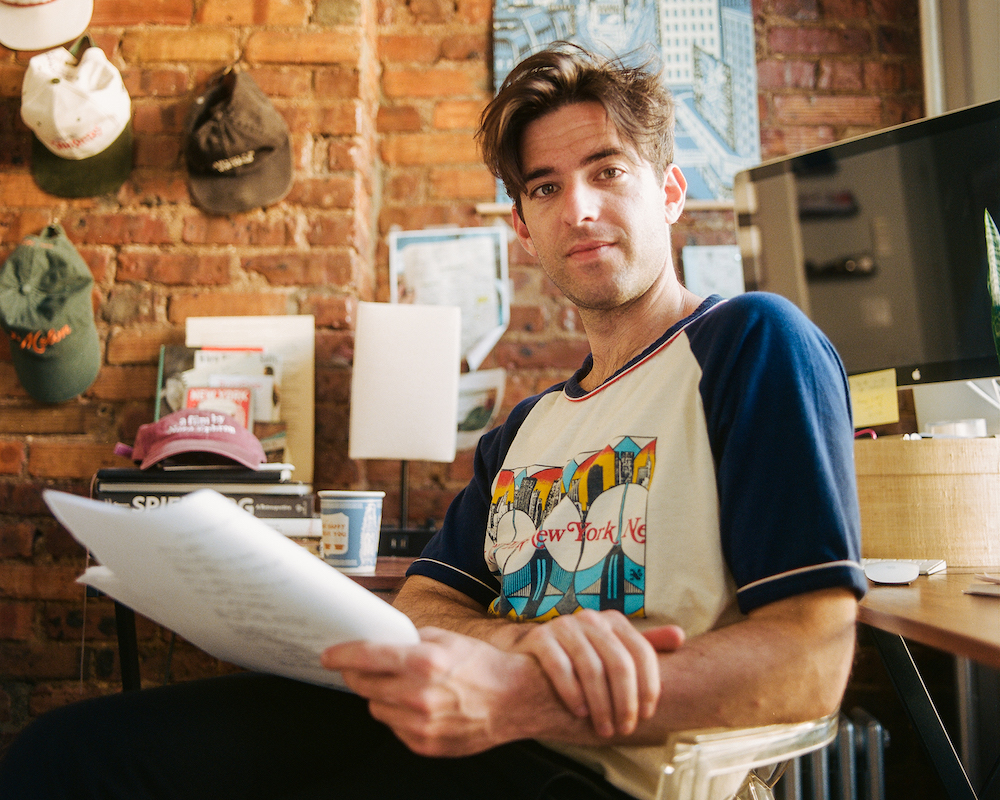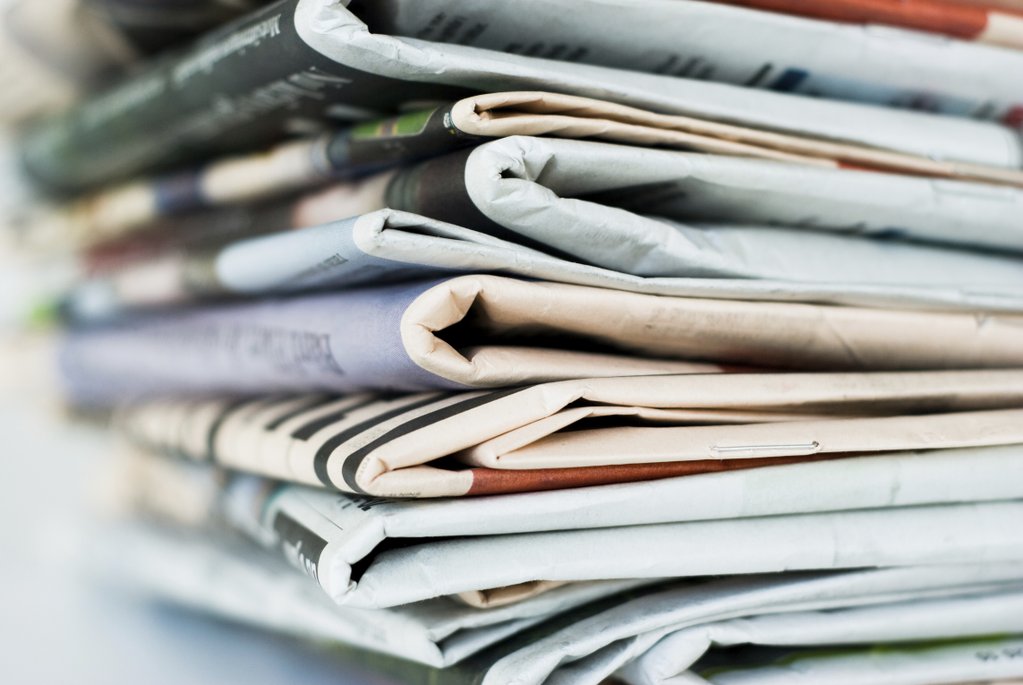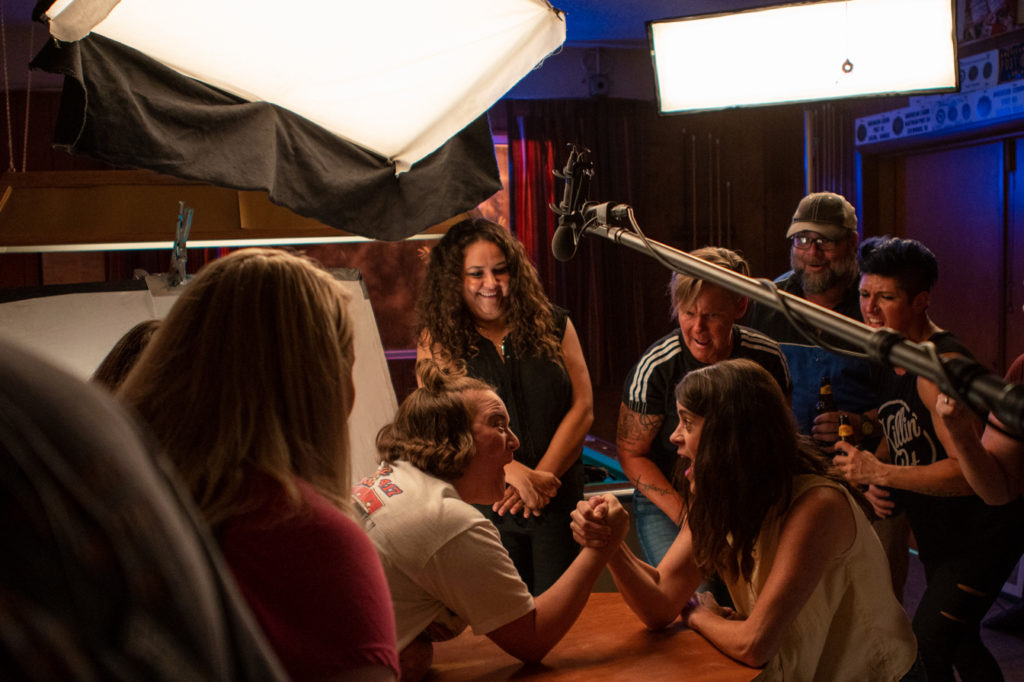As a native New Yorker who watched When Harry Met Sally… on repeat, JONAH FEINGOLD was maybe destined to make a romantic comedy, even before he ventured west to attend USC Film School. While gaining behind-the-camera experience through a string of new media shorts, including the Kickstarter-backed Bangarang and Facebook Watch’s Maybe: Josh, Feingold continued his rom-com due diligence (eventually even hosting a podcast for the Hinge dating app called Dating Sucks). After a decade in LA, he went back to NYC to begin production on his feature directorial debut: A millennial take on the Nora Ephron oeuvre, DATING & NEW YORK.
Dating & New York follows romance-seeking Milo (Jaboukie Young-White) and commitment-phobic Wendy (Francesca Reale) as they meet on a dating app and attempt to forge a relationship — as friends with benefits. Catherine Cohen, Brian Muller, and Jerry Ferrara co-star in the film, which premiered at the 2021 Tribeca Film Festival. The indie romantic comedy will hit theaters and VOD on September 10, courtesy of IFC Films.
We interviewed writer/director/producer Jonah Feingold about his favorite movie genre, filming in New York City, completing the film during COVID, and more.
——
COLIN McCORMACK: How did the brainstorming and writing process start for what became Dating & New York?
JONAH FEINGOLD: Fantastic question. I am obsessed with romantic comedies and I had felt there was not a film that accurately depicted the minutiae of modern dating in the rom-com space. And completely understandably why – pitching a movie that’s all about “I miss you” texts and Instagram stalking and conversations about posting in the grid versus in Stories – is very specific and perhaps not necessarily inherently commercial. I’ve grown up loving rom-coms, fantasy movies, family movies, comedies, and [was] trying to figure out how to enter into the film space as an indie director and how to make a movie that I could both try to raise the funds to go shoot but also still make it impactful. It all culminated in these shorts I was making and these jobs that I had as a content creator for places like BuzzFeed and Refinery29. Ultimately, Dating & New York was that; it was a movie I thought we could go out there and make, yet also said something interesting and new about the modern rom-com and what that could potentially look like.
CM: And I assume hosting the podcast for Hinge helped with some of the research? I can only imagine you heard a lot of dating stories – both horrifying and romantic?
JF: Correct. Funny enough, hosting that podcast actually happened after we shot. I was able to use some of that vernacular in our post-production process in terms of either confirming certain things in scenes, where we would test out scenes with audiences and I could add something into the text messages, for example, because that was all done in post. But also just to build an audience and understand there is a group of people out there who really are interested in the minutiae, [are] social anthropologists, people who are curious about the way that we date and the way that technology has affected our dating life. And Hinge got me this fancy mic and I still get to use that, which is nice, and I have a Hinge hat, which is cool. But for the most part, I try to stay away from all things Hinge if I can [laughs].
CM: In the movie, Cat Cohen’s character at one point breaks down the story beats of a romantic comedy. So what were some of the beats or tropes of the genre that you either wanted to include or steer clear from or flip on their head?
JF: I wanted to include the basic structure. The structure of the film is sort of on-the-nose: They meet, they break up, they get back together, although there’s a twist there. But it’s the “friends with benefits” situation. Can you be friends with someone and also be romantically sleeping together or in a relationship of some sort? Interestingly enough, our characters start off with the benefits and they turn that into a friendship, which I think is inherently different from a Friends with Benefits or No Strings Attached or When Harry Met Sally…
I wanted to stay clear of this rom-com trope that I actually love watching, but wanted to see if we could do something that wasn’t this, which is two characters really hating each other at first. You know, the big bookshop owner versus the small indie one or the two reporters who are keeping their secrets or the sports marketing guy and the article writer for Cosmo. This idea that you are butting heads inherently, which really makes for good rom-coms. All the great Anne Fletcher movies like 27 Dresses and The Proposal, all these films do that butting-heads thing really well. I wanted to see if we could make a rom-com where their meet-cute was simply just swiping right on an app and where does that go. And they don’t hate each other at first. They never really hate each other, they are just their own internal worst enemies. [It’s] the psychological thriller of romance.
And I wanted to embrace old-school filmmaking techniques. I wanted to embrace the use of score and theme. There’s not one handheld shot in this movie, it is more supposed to have this fairy tale tone to it. I think those were the tropes I was excited to pull from – His Girl Friday and Shop Around the Corner and the old MGM movies – and to still make New York feel modern.
CM: There’s obviously the parallel to When Harry Met Sally… and some of the other films you mentioned. Are there any romantic comedies – as someone who I’d say is an expert in the genre – that are under-the-radar that you drew inspiration from?
JF: There are two, specifically. And to some, this might not be under the radar, to others, it might be. One is called Modern Romance that is directed by Albert Brooks. That was the first time I saw a rom-com where I was like, Wait, you can just have a rom-com about an overly-sensitive, neurotic character who is not necessarily bad or good but still explores the minutiae of dating? That movie has a very similar ending to our movie. That was made in the ‘80s, I believe. And then a film called L.A. Story that I love, which is a Steve Martin movie. It’s just the perfect blend of magical realism and comedy and I wanted to channel even just a fraction of that. In that movie, the LA billboards speak to him during a rainstorm and they’re playing Enya music and we took a little bit of that, we did the subway signs. That movie was incredibly impactful to me in terms of, You can make a rom-com that’s fantasy-blending. And there’s Joe Versus the Volcano, which is another one that does that really well. I would say those three films were the ones off the beaten path that really inspired it.
CM: When did the project really get off the ground as something you could think of as, “Wow, this is really going to happen”? Was there a specific moment where it sort of became real?
JF: [Laughs] You know, it didn’t feel real even until we were done. This is perfect for [this] conversation. The second I realized that it doesn’t magically feel real. I call it reverse Pangea: You are financing, casting, and prepping all at the same time on an indie level, everything is getting in your way in terms of you’re not going to hit your start date. Then the second that we said, “We’re shooting. Let’s just call it. November. We’re going to make a movie.” The second everyone started saying you’re going to make a movie, it wasn’t this one big leap. It was, “Okay, let me text the department heads and say we’re going to go on a scout.” Then you’re scouting, then you’re talking about the script in a new way.
I think for me it felt perhaps the most real when I onboarded my cinematographer Maria [Rusche] because she helped us get our line producer and our AD and the more we were shot-listing, the more that would inform the script and the locations. Then once we started getting actors involved, I think the first person I technically cast was Jerry Ferrara. And once I said to him, “I want you to play this doorman role,” that was able to open more doors. Because then you go out and you’re casting and you say to your casting directors, “Hey, Jerry Ferrara’s involved” and that will help maybe get someone like a Jaboukie or a Cat want to get involved as well. Then, ultimately, you’re two weeks out from your start date. You know what does feel real? When you’re walking to your set and you see that New York Parking sign that says, “For any problems, call our location manager Ryan,” and “Shooting from 5 a.m. – 5 p.m.,” that was when I was like, Holy shit, we’re actually making a movie. But the money wasn’t in the bank until the day before. We were still casting while we were shooting. It never just magically happens, but once you realize that you gotta trust it, then it does start to [become real].

CM: You spoke a little about fantasy and magical realism. For the visual inspiration, where did you look?
JF: For the visual inspo, we looked at a lot of the classic ‘90s rom-coms like You’ve Got Mail and Harry Met Sally, we looked at L.A. Story. We looked at the work of a cinematographer named Dean Cundey, who shot early Spielberg movies and all the movies we ‘90s babies grew up watching. Also, Marie and I talked about what we wanted. We talked about it wanting to feel magical and have a glow and feel like almost a vintage Disney movie. If you look at the opening sequence, there’s a shot of our two characters and their first kiss. And it is not the obvious choice to make this grand fairy tale music, very soft images with tons of backlight; that’s not what a New York makeout really is. On the street in New York, it’s gritty and it’s noisy and it’s hot. But of course, ours has these trash bags they’re surrounded by, so it does pay off in a way. Norman Rockwell was a big inspiration, we looked at a lot of Norman Rockwell art because of the way the characters were dressed and staged. We looked [for] “vintage.” It had to be ‘50s and ‘60s, it had to feel timeless. That was the impetus for the look and feel of most of the film.
CM: How long was your shoot?
JF: 15 days.
CM: So you shot in New York on subways, on a ferry, in parks, in 15 days. How did you manage to pull that off and what was the most precarious location?
JF: We sound like a professional tour guide company. How did we do it? One is that I had been making short films and content for a very, very long time. So a lot of the things we see in the film were things we went in as a team knowing exactly what we wanted. There was never a moment of, Let’s figure this out. It was always, This is what we came in here to do. Always maintained a positive attitude and not let the weather or the loss of light get in the way of good storytelling and having fun. This is a testament to our production crew, to our cinematographer Maria, to our line producer Kieran [Altmann], to my producer Joaquin [Acrich], our AD Katie [Schiller]. Everyone knew the vision and we were just a moving train. We shot 22 locations over the course of 15 days. I would recommend any indie filmmaker trying to make their first feature in New York City that you keep the amount of shooting days higher than the amount of changes of locations. Simple rule! [Laughs]
The most difficult place to shoot, there were two. The ferry was really difficult because it was 4 a.m. [when] we were there, 24 degrees, it’s a oner, they’re walking on the ferry, it’s cold, you can’t hear a word they’re saying. I felt like I was directing Pirates of the Caribbean, which was awesome. And everyone had a great time, it was a positive attitude, but everyone was like, “What are we doing here, Jonah?” I’m like, “It’s an important scene! You guys are talking about the date from last night!” I would say that one and ultimately the Washington Square Park [scene] because – one of the beautiful things I love about New York – when you shoot here, everyone wants to be involved. Whoever’s walking by. Funny about the subway scene is that nobody looked in the camera. It was amazing to me when you look at that scene, a lot of those people aren’t our extras and no one gave a shit. It was hilarious and amazing and that’s what I love about New York. Everyone’s in their own world.
CM: We got places to go.
JF: We got places to go, I don’t need to be in your indie movie. In Washington Square Park, though, because it was more tourists perhaps, [they were] lining up, looking at Francesca trying to do her scene. I have a 16-track dolly. We had one production coordinator who’s a 6’ 6” football quarterback type and my AD Katie said, “Roger, you’re gonna go block everybody.” And this big dude – we all love him – he’s got his hands up so no one can get in the way of the scene. And big respect to our actors, Francesca and Jaboukie and Cat and Brian and everybody, because half the scenes they did they’re sort of doing it like a [live] show; they’re out in public doing this stuff. So a lot of respect to them for that.
CM: Speaking of location, you spent a lot of time in LA and went to film school out here. When you went back to New York to start production on this, did you have a community of collaborators already there or did you have to build up a new crew?
JF: That’s a great question. I didn’t. I had my whole LA team that I’d been making movies with for seven years. Short films, commercials, and all that jazz. It was as easy as, You got the gig? Pick up the phone and you’ve got your DP, your AD, and everyone’s there. I came to New York and didn’t really know anybody. I had been a fan of Maria’s work and when I brought Maria on, she recommended the two producers she had just worked with. They all went to NYU together, they had just made a film together, and it was so simple. Like, We just did a movie in this budget range. Let’s come on and do your film. I was like, “You all went to NYU together and seem to love working together. Perfect, that’s what I want.” So it was kind of like meeting your new family and you get opened to the New York world of production. New Yorkers like to make stuff, so it was very easy to be like, “Let’s pick up the camera and go do this thing.”
CM: You filmed in the fall of 2019?
JF: Yeah.
CM: So does that mean when the pandemic hit, were you already deep in post-production? What point were you at when things started shutting down?
JF: We wrapped basically December 1, or something like that. And we started editing – my editor Hanna Park and I, who was amazing because she was working a full-time job at Viacom, so we would cut out of her office every night from like 6 to 10 p.m. She’s incredible and we were working together for a couple of weeks and then one day, everyone stopped showing up. We’re like, Wait, maybe we shouldn’t be here either. There was a rough cut of the film and we entered into the COVID-era of this process remotely when we were testing the movie as a whole, which is the hardest part because you’re moving act structure around, you’re moving scenes around, you’re changing tempo. It’s things that require being in a room together and really hashing out how it’s going to play. Then we, of course, did color, ADR, scoring, sound mixing, all remotely. You hear about a lot of studio movies that do that and that’s really impressive and cool, but do you know how much harder that is to do when you have no more money left and you’re an indie movie? [Laughs] It’s impossible. So it’s a big testament to our post team and to Hanna for being able to coordinate such a masterful element of storytelling and executing notes, all while doing it remotely.
CM: In terms of testing or friends and family screenings, were you able to show it to a large group of people, or is that what the premiere ended up being?
JF: We had one in-real-life test screening at NYU, where we invited friends-of-friends; people we didn’t necessarily know. Maybe ten people and some other trusted creatives. We did that in real life. Then a majority of our tests – our most effective ones – were actually over Zoom. We would either show the movie over Zoom and I would track people when they were laughing, or we would do it like, “Here’s a link, watch it, then we’ll hop on.” We did a couple of those. And it was fine, but I still haven’t really seen the movie with a huge audience. So when it comes out September 10 at IFC, that will be the first time I watch it with, hopefully, plus-100 people. We made it work and I’m really happy that we did.
CM: In terms of [forming] a festival or release strategy while so many things were up in the air within the industry, were you moving forward with your initial plan? Was it a wait-and-see approach? Do you just submit to festivals not knowing if they’ll be in-person or not? What was that process like?
JF: Colin, I was going insane. It was winter in New York. I’m someone who loves to create and put stuff out there. I’m of the YouTube generation where if I made a short film, it went on the internet, I could release it and send it to my friends and family. Actually, the first time I had any type of success was when I made a viral trailer for something that got a million views overnight. So I was biased towards this process but my producers talked me off many ledges of wanting to release the movie on iTunes. “Let’s drop it on Valentine’s Day! Everyone’s at home, they need a good rom-com!” They said, “Look, we submitted to Tribeca. This is a wonderful festival for this movie. Give it a shot.” So actually, right behind me is the letter that I wrote to Tribeca that I kept in a Nora Ephron book for good luck. And it worked out that we got in. Once we got into the festival, we were able to start approaching buyers about this film. There was always a plan about getting the movie onto peoples’ computers so they could watch it. The industry had never really rewarded me in any way; I’ve never been hired for a gig or had a script sold, I’d never gotten into a festival before. So I was always sort of skeptical of applying to a festival because I’m not going to get in. And once we got into Tribeca, I was like, “Wow, maybe this industry does reward years of hard work and luck and timing.” That was very exciting and, obviously, a dream come true to play at Tribeca.
CM: Now that the film is going to shortly be released to the masses, what’s next for you?
JF: What’s next is a romantic comedy called The Bar Downstairs and it’s a rom-com in the vein of You’ve Got Mail and Chef. I’m working on the latest draft and approaching the same financiers but also approaching certain studios about doing it together and we’re getting good responses. But look, we shot [Dating & New York] for 15 days almost two years ago. The part that most directors love about this is being on set, so I’m very excited to hopefully get back on set soon and keep making rom-coms.
__
Thanks to Jonah for chatting with us about the DATING & NEW YORK. Learn more about the film at datingandnewyork.movie.
This interview has been edited for clarity.
If you’re an independent filmmaker or know of an independent film-related topic we should write about, email blogadmin@sagindie.org for consideration.




